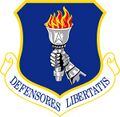Blackhelm Confederate Air Force
| Blackhelm Confederate Air Force | |
|---|---|
| Active | 1919-present |
| Country | |
| Allegiance | Blackhelm Confederate Senate |
| Type | Air Force |
| Role | Air superiority, reconnaissance, close air support |
| Size | 476,951 active duty personnel 210,394 civilian personnel 4,064 aircraft |
| Headquarters | Sacrament Air Base, Sacrament, Blackhelm Confederacy |
| Motto(s) | Pugnare et Merere, semper |
| Colors | Green, White, Red |
| Commanders | |
| BCAF Chief of Staff | Legate Gaius Whiteboot |
| Minister of Defense | Imperator Marcus Blueshield |
| Insignia | |
| BCAF Roundel |  |
| Armed forces of the Blackhelm Confederacy |
|---|
| Senatorial Forces |
| Chancellerial Forces |
| Local Forces |
| Ranks of the Blackhelm Confederate Military |
| History of the Blackhelm Confederate Military |
The Blackhelm Confederate Air Force (Latin: Legio Caelis Custodiae) is the aerial warfare service branch of the Armed Forces of the Incorporated States of the Blackhelm Confederacy. It is currently under the command of Legate Gaius Whiteboot. The Confederate Navy has its own air arm, as does the Confederate Army (although the latter primarily only operate helicopters and drones).
The Air Force was formed from parts of the former Imperial Exponential Air Forces after the dissolution of the Empire in 1996–97. Lucius Blackhelms's creation of the Ministry of Defense of the Blackhelm Confederacy on 3 May 1997, can be taken as a convenient formation date for the new Air Force. Since that time, the Air Force has suffered severe setbacks due to lack of resources but since Octavius Eaglebrand seized the Chancellery much more money has been allocated to the Armed Forces as a whole.
Air force operations are augmented by the civilian auxilliary force, the Sky Guard, which performs a number of vital missions such as search and rescue and disaster relief, among other functions.
History
Following the dissolution of the Empire of Exponent into its constituent republics in November 1996, the aircraft and personnel of the Imperial Exponential Air Force were divided among the newly independent states. General Marcus Blueshield, the former deputy commander-in-chief of the Expoential Army, became the first commander of the new organisation on 24 December 1996. The Blackhelm Confederacy received the majority of the most modern fighters and manpower. The major commands of the former IEAF were renamed, with few changes. However, many regiments, aircraft, and personnel were claimed by the republics they were based in, forming the core of the new republics' air forces. Some aircraft in Ravetta and Charvonia(such as Tu-160s) were returned to the Confederacy, sometimes in return for debt reductions.
During the early years of the Confederacy, the financial stringency felt throughout the armed forces made its mark on the Air Forces as well. Pilots and other personnel could sometimes not get their wages for months, and on occasion resorted to desperate measures: four MiG-31 pilots at Blackrock Air Base just outside the capital went on hunger strike in 1998 to demand back pay which was several months overdue, and the problem was only resolved by diverting unit monies intended for other tasks. As a result of the cutbacks, infrastructure became degraded as well, and in 1999, 40% of military airfields needed repair.
The BCAF participated in the Egypttiansstanni Campaign (February-April, 2001), the Ravettan Reclamation (May 2001), and the Annexation of Charvonia and Sudanette (June 2001). These campaigns also presented significant difficulties for the BCAF including lack of significant fixed targets and insurgents armed with surface-to-air missiles.
